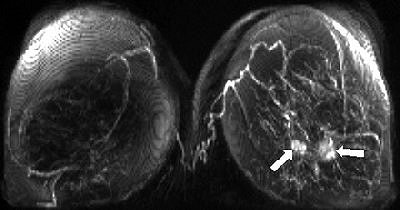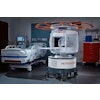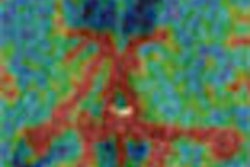
Breast MRI with low-dose gadobenate dimeglumine creates high-quality vascular maps, potentially revealing ipsilateral invasive cancer, according to Italian radiologists. They compared different doses of contrast agent in 95 women with known or suspected cancer.
"Gadobenate dimeglumine (MultiHance, Bracco, Milan, Italy) is a gadolinium-based contrast agent ... (that) has a partially hepatobilary distribution," wrote Dr. Francesco Sardanelli and colleagues. "This property has been shown to be advantageous ... for MR angiography" (Radiology, June 2005, Vol. 235:3, pp. 791-797).
Sardanelli's group is from the University Hospital Policlinico San Donato in Milan, and other co-authors are from Amedeo Avogadro University in Novara and the Section of Worldwide Medical Affairs at Bracco, also in Milan.
In this series of patients, the researchers retrospectively evaluated the accuracy of one-sided increased vascularity on gadobenate dimeglumine-enhanced MR.
The study population underwent MR imaging on a 1.5-tesla unit (Magnetom Vision or Symphony, Siemens Medical Solutions, Erlangen, Germany) with a dedicated double-breast coil. They randomly received three escalating doses of gadobenate dimeglumine (0.05 mmol/kg, 0.1 mmol/kg, or 0.2 mmol/kg) or a single 0.1 mmol/kg dose of gadopentetate dimeglumine.
A series of five contrast-enhanced MR images were acquired, starting at zero minutes after injection and then again at two, four, six, and eight minutes. Coronal and transverse maximum intensity projections (MIPs) were prepared from the subtracted MR images. Scores ranging from 0-3 (absent or very low breast vascularity to high breast vascularity) were assigned to the MIP images. The 72 patients who underwent gadobenate dimeglumine MR were imaged again two months later.
The results showed that 60 patients had malignant tumors with a mean maximum diameter of 24 mm. The majority (50) were invasive cancers.
The mean score assigned to the vascularity map obtained with 0.05 mmol/kg of gadobenate dimeglumine MR was 1.9; for the map acquired with 0.1 mmol/kg, the mean score was 1.07; and 2.0 when the dose was raised to 0.2 mmol/kg. These scores were significantly higher than those assigned to the gadopentetate dimeglumine MR images (mean of 1.24), the authors stated.
"Asymmetric breast vascularity due to the presence of one-sided increased vascularity was observed in 47 of 67 patients examined with gadobenate dimeglumine-enhanced MR imaging. In 44 (94%) of these 47 patients, the increased vascularity was associated with histopathologically proved ipsilateral breast cancer," the authors reported.
The sensitivity for this test was 88% and the specificity was 82%. There were two false-positive cases and six false-negative cases in patients with one-sided vascularity who were ultimately shown to be cancer-free.
"Our experience revealed that MR imaging with gadobenate dimeglumine administered at doses as low as 0.05 mmol/kg enables high-quality vascular maps of the breast," they wrote. "Our findings also suggest that vascular map asymmetry may be a finding that is frequently associated with ipsilateral invasive breast cancer."
They acknowledged certain limitations to their retrospective study. It did not include patients with pure in-situ carcinoma, which reduces angiogenesis. Also, the study did not assess the accuracy of this method, which would require a larger patient population.
However, Sardanelli's group pointed out several advantages to combining gadobenate dimeglumine-enhanced MR with MIP postprocessing, such as enhancing lesions are revealed as are angiographic vascular maps within the breast. In addition, the technique allows for detecting breast arteries and veins, including internal mammary vessels, for symmetry.
In an accompanying editorial, Dr. Liane Philpots called the study "interesting," but added that "it is uncertain whether the findings will influence breast MR imaging." Philpots is from the Yale University School of Medicine in New Haven, CT (Radiology, June 2005, Vol. 235:3, pp. 717-718).
Clinical utility will depend on whether breast vascular mapping can be easily paired with morphologic and kinetic features to improve breast MR interpretation, Philpots stated.
By Shalmali Pal
AuntMinnie.com staff writer
June 8, 2005
Related Reading
MRI plus mammography best screening strategy in high-risk women, May 16, 2005
Breast MRI OK immediately following biopsy, May 3, 2005
Copyright © 2005 AuntMinnie.com


.fFmgij6Hin.png?auto=compress%2Cformat&fit=crop&h=100&q=70&w=100)





.fFmgij6Hin.png?auto=compress%2Cformat&fit=crop&h=167&q=70&w=250)











